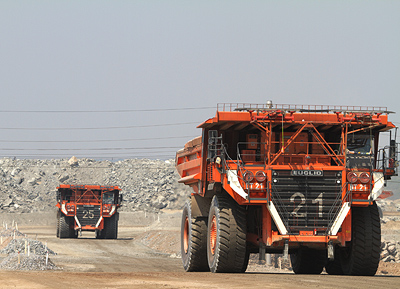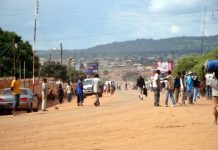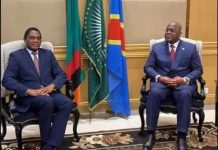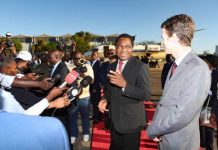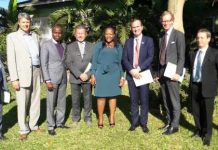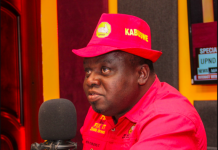Tough economic times have hit Australia’s shores and miners are no longer equipped to bear the brunt, but as one mining executive explains, even at the darkest hour there is opportunity.
Equinox Resources was the child of explorative entrepreneurs Craig Williams and Bruce Nisbet.
Together Nisbet and Williams worked under the guise of Hunter Resources discovering the Nimary gold deposit, which is now owned by Newcrest and the now Equigold controlled Dalgaranga gold deposit.
Fed up of making significant discoveries which line other people’s pockets the pair set off to do it for themselves.
“With our track record the pieces started to fall into place,” Williams said.
In September 1994 Equinox raised $9 million, set a focus on iron oxide copper gold [IOCG] deposits in the Cloncurry and Gawler Craytons districts and Equinox was born.
The early to mid 1990s weren’t the smoothest of times for Australia’s mining juniors and explorers but Williams stated there is opportunity in tough times.
At the time Native Title claims were causing headaches in Australia’s mining sector so Equinox made the decision to go offshore, first to Sweden and then to Africa after Anglo American approached the company.
“We were approached in mid 1996 by Anglo American asking: ‘Why don’t you come to Africa and we’ll foot the bill?’,” Williams said.
Equinox secured a deal with Anglo to explore for base metals in Africa, and the targets were handed over to Anglo in 1999.
But Equinox’s appetite had not yet been satisfied and so in that same year the company struck a joint venture deal with Phelps Dodge, securing a 51 per cent stake in the Lumwana copper project.
Located in Zambia, one of the world’s largest copper producers, Lumwana at the time was considered uneconomic because of the then low copper price which was sitting around US.60c/lb.
Acquiring world class assets at the bottom of the market was to be Equinox’s strength.
The company managed to fund a $10 million feasibility study in 2003 which showed but Phelps Dodge decided not to continue in the project.
As a result in 2005, Equinox bought the 49 per cent stake from Phelps Dodge for $5 million and the miner went in search of funding.
Equinox quickly realised Australian investors were showing little interest in Africa and set its sights on Canada, facilitating a TSX listing in order to acquire AUD$800 million of equity funding and another AUD$640 million in debt financing, all on the back of a $7 million market cap.
Construction at Lumwana commenced in 2006, remaining on track and looking very promising with copper floating around $3/lb.
But in July 2008 a transformer fire in the mill delayed commissioning 5 months, and was to be the first of Lumwana’s issues.
In September 2008 the GFC hit just as Equinox had to raise another $80 million, and in quarter 1 2009 the first load of copper was sold but the previously high copper price was now sitting at $1.38.
“We still made money at $1.38,” Williams said.
But the company’s unforseen woes weren’t to end there.
In 2009 landlocked Zambia experienced a record wet season and the ramp up of material movement took longer than expected.
It wasn’t until the following year that Equinox managed to secure a reprieve; copper rose in 2010 to jump between $3 and $4/lb, the site produced 147,000 tonnes of concentrate delivering $1 billion in revenue, and the company was now cash flow positive.
For many achieving cash flow positivity would be enough, but the dogged determination that was now instilled in Equinox’s culture meant it wanted more of the pie.
The company launched a $1.25 billion take over of Citadel Resource Group which at the time controlled Saudi Arabian asset Jabal Sayid which at the time was expected to begin production half way through 2012.
It also initiated an unsuccessful $4.8 billion hostile take over of Lundin Mining in 2011; if the acquisition was to be successful it would’ve made Equinox the 9th largest global copper producer.
“It was an aggressive move,” Williams said.
“It didn’t come off and growth achievements and expansions started to attract the attention of others.”
Not long after a hostile bid for Equinox was launched by China Minmetals at $7 a share.
“We said this was inadequate and opportunistic,” Williams said.
But in April 2011, Barrick Gold moved in offering $8.15 per share, valuing Equinox at $7.3 billion.
“It was a hell of a ride,” Williams said.
“When we closed we were Australia’s 37th largest listed company and 7th largest mining company.
“Globally we were the 20th largest copper producer and Jabal Sayid [the previously mentioned Saudi asset] would’ve moved us to 15th.”
Equinox’s story is reminiscent of a mining fairytale, moving its way up the ranks from a $5 million market cap junior to a multimillion dollar producer, delivering original .6c shareholders a gain of almost 14,000 per cent over 11 years.
“Very few companies evolve from explorers to global producers, maintaining independence and not having to sell down asset ownership,” Williams told the Sydney Mining Club.
Williams explained Equinox’s difference was its dogged determination to keep going, persistence for acquiring finance, and its ability to maximise leverage from robust copper prices.

 JOIN DRIVERN TAXI AS PARTNER DRIVER TODAY!
JOIN DRIVERN TAXI AS PARTNER DRIVER TODAY!